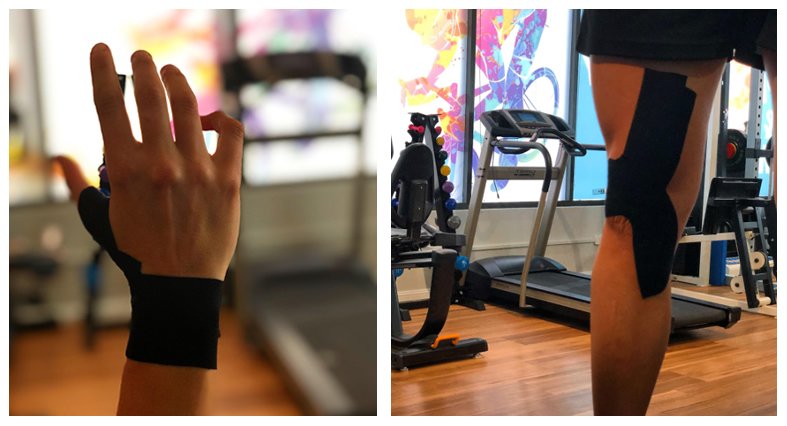Taping? Is it effective in reducing injury?
Taping? Is it effective in reducing injury?
Taping for all sorts of conditions has become a popular and heavily debated topic.
One of the many questions we get asked as physios is “Will taping prevent injury?”
It is important to note that there is nothing that can absolutely PREVENT injury. However, there are many different ways to REDUCE injury risk. Taping is mainly used to provide ASSISTANCE and REDUCE the risk of re-injury.
"Nothing can absolutely prevent injury"
We can only reduce the risk!
There are 2 types of tape we use at our practice, depending on your goals:
1. Kinesiology tape (also known as K tape) is an elastic styled tape
Mainly used as an external cue to help improve positioning or muscle activation patterns. Some ways we use K-tape is for:
Patella (knee cap) taping
To support the inside arch of the foot
To assist with posture
To assist with shoulder positioning
To assist with wrist positioning/thumb positioning
To help support muscles
If your goal is to improve positioning - then using K tape is your go!
2. Rigid tape
Mainly used for ligament sprains and to restrict excessive motion at a joint. Some ways we use rigid taping is for
Sprained ankles
Sprained ligaments of the knee (MCL, LCL, ACL etc)
Shoulders (following shoulder dislocation to prevent excessive movement)
Elbow ligament sprains
Wrist sprains
Patella (knee cap) taping
Plantar fasciitis
If your goal is to restrict excessive motion of joints or compress the injured area, then rigid tape is your go!
Taping is more effective in reducing ankle sprains in athletes with a history of ankle sprain than in those without a history of ankle sprain
What are the benefits of taping?
Restricts excessive motion and assists with joint stability
Helps reduce some pain/symptoms
Influences biomechanics/movement
Helps improve force sense error (example: Taping to assist pronation– you may ‘feel’ the tape pull if your foot pronates, cueing you to avoid this)
Assists with joint positioning
Helps to offload certain structures
Helps to reduce swelling
Psychological benefits
Common taping myths
Taping improves strength: Taping DOES NOT improve strength - you have to do exercises for this
You should tape to prevent injury: Nothing prevents injury, we can only reduce the risk + you would be better improving your strength and motor-control instead!
I should wear tape to mask my pain: You should never wear tape to mask your pain, but it does help to reduce it! If you still have pain playing whilst wearing tape, you could be doing more damage.
I should tape an uninjured area to avoid injury: This is FALSE. Again, nothing prevents injury! In this scenario you would choose to strengthen the area instead!
When should I tape then?
Taping after injury and returning to sport for the first time is always beneficial and is something we recommend to reduce further injury (such as after a sprained ankle)
If you require help with positioning
To offload certain structures
To help relieve pain/symptoms in the short term
To learn more about taping or how to tape, Jannali Physiotherapy is hosting a taping workshop. We will be covering knees, ankles and feet.
If you are interested in attending this event or would like to find out more please email admin@jannaliphysio.com.au or phone 95894014
References
https://www.ncbi.nlm.nih.gov/pmc/articles/PMC385268/
Aminaka N, Gribble PA. A systematic review of the effects of therapeutic taping on patellofemoral pain syndrome. J Athl Train. 2005;40(4):341-51.
Howe A, Campbell A, Ng L, Hall T, Hopper D. Effects of two different knee tape procedures on lower- limb kinematics and kinetics in recreational runners. Scand J Med Sci Sports. 2014 Jul 2. doi: 10.1111/sms.12269. [Epub ahead of print]
Merino-Marban R, Fernandez-Rodriguez E, Mayorga-Vega D. The effect of kinesio taping on calf pain and extensibility immediately after its application and after a duathlon competition. Res Sports Med. 2014;22(1):1-11.
The Effectiveness of Low-Dye Taping in Reducing Pain Associated With Plantar Fasciitis
Patellar taping: is clinical success supported by scientific evidence?


